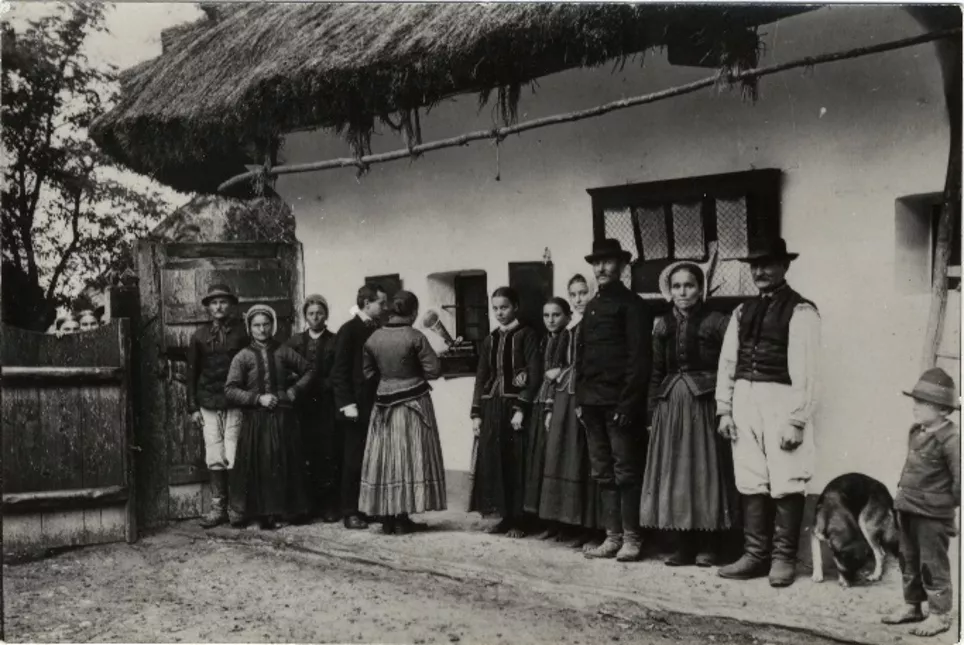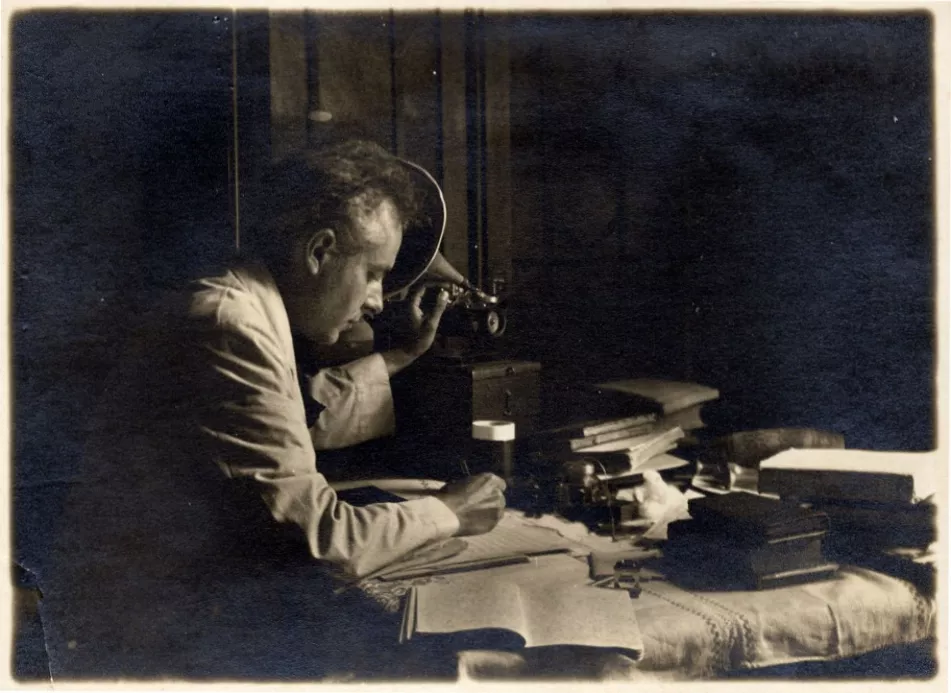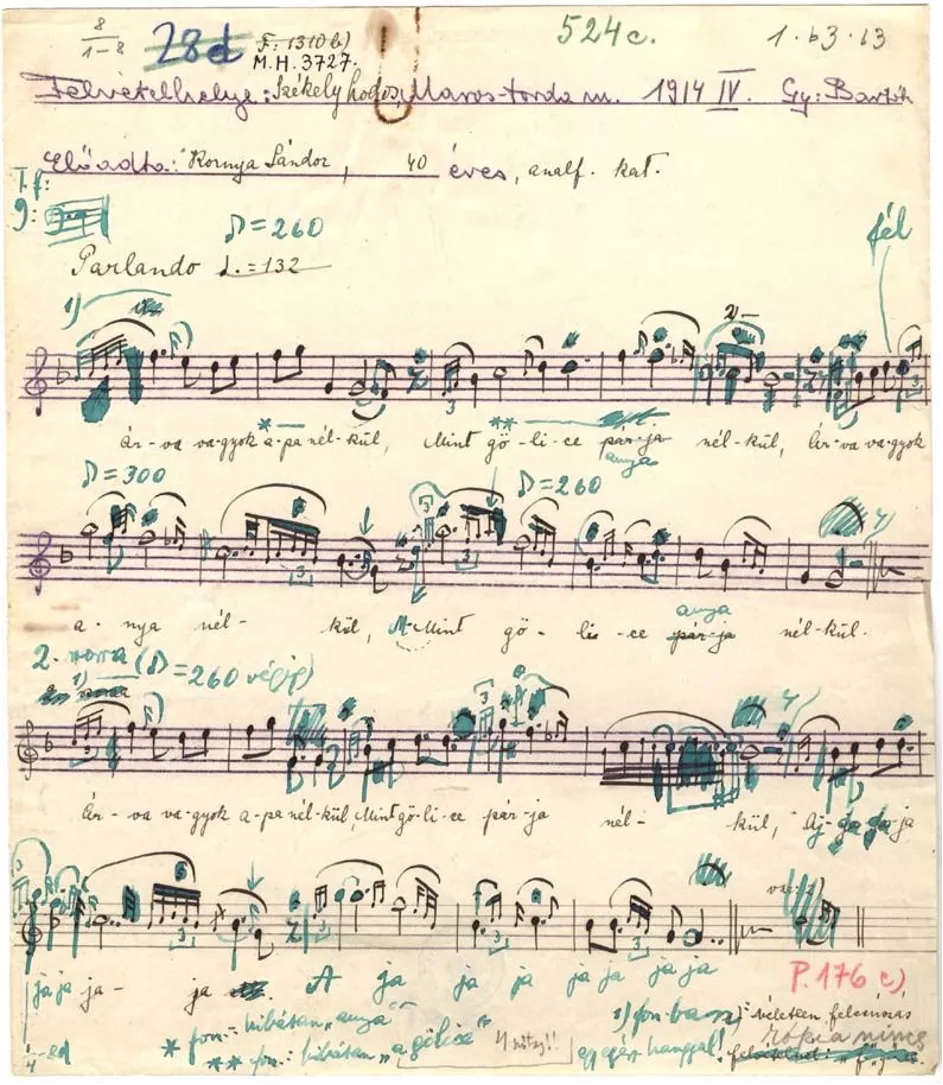Around a third of Béla Bartók's works are arrangements of folk songs that the composer overwhelmingly selected from his own collection consisting of some 10,000 melodies originating with various different nationalities. The Bartók Archive's new database, based on the catalog compiled by Vera Lampert (Folk Music in Bartók's Compositions: a Source Catalog, Budapest, 2005), makes public – wherever possible – the complete source material for these folk melodies and presents, along with phonograph recordings of inestimable value, notations of the variations on them for which written records exist. Presenting the database here is co-editor Viola Biró, a researcher at the ELKH BTK Institute for Musicology.

Bartók collecting folk songs in Zobordarázs (today's Dražovce, Slovakia) in 1907 Source: Bartók Archive, Budapest
The "Folk Music in Bartók's Compositions" database presents the folk music background that gripped Bartók's creative imagination. The database offers answers to questions such as how Bartók cataloged the melodies as he collected them, what comments he added to the entries, and how he further refined his records – sometimes several decades later – in order to create the most precise possible "snapshot" of a given performance of a constantly changing folk song. The phonograph recordings of the folk songs and the various notations on them give a fairly close and nuanced picture of the melodies that serve as sources for the work. A thorough analysis of the folk music sources combined with a comparison with the composition itself provides a glimpse into how the composer worked: we can observe how Bartók related to the source folk music, when he adhered strictly to every detail of the notation and when and why he handled a melody more freely – in other words, how a composition was created out of a folk song.
The database makes public all the written and audio sources available to us that most likely served – according to the best of our current knowledge – as sources for the folk melodies used in Bartók's works, thus making manuscript sources that were previously only available to a narrow group of researchers freely accessible to everyone.
Arrangements of folk songs are present across Bartók's entire ouevre. Simultaneously with his Rhapsody (Op. 1), his first mature composition and one that openly declares his creative coming of age, he wrote his first reflection as a composer on his encounter with folk songs in the form of his arrangement of the Szekler folk song "Piros Alma" ("Red Apple") he collected from Lidi Dósa in 1904. It was the experiences he gained on his historically important 1907 tour of Szeklerland that decisively influenced the development of the markedly individualistic avant garde composition style that followed it. Attesting to this is an entire succession of folk song arrangements – including the For Children series of treatments of Hungarian and Slovak folk songs he wrote for pedagogical purposes, as well as the three series of arrangements of Romanian folk music, the Romanian folk dances and Christmas carols and his Sonatina, which were all presumably intended as a continuation of the former.
The later development of his style was also followed by arrangements of folk music. Dating from the same period as his boldly modern compositions from 1918-20, The Miraculous Mandarin and Etudes, Improvisations reaches "the ultimate boundary in the interconnecting of simple folk music and quite daring experimentation." A major milestone in his artistic career came with the arrangements of folk music, written after his compositions from 1926, that simultaneously reflected contemporary trends – especially the works of Kodály. These include the two violin rhapsodies (1928–29), Twenty Hungarian Folksongs for Voice and Piano (1929) and Hungarian Folksongs for Mixed Choir (1930), all masterpieces of his classically mature style.
As Bartók stated, “To be able to deal with folk melodies is one of the most difficult tasks […] It is as difficult, if not more difficult, than writing a large-scale original work.” Writing arrangements of folk songs proved to be a superb school for the young composer. Folk music, then still utterly foreign to urban culture – and which the composers themselves sometimes travelled to distant, romantic regions in order to study – was the best starting point for Bartók and Kodály, on the cusp of their careers, to create the “new Hungarian music” and a modern but uniquely Hungarian musical language that breaks with the already fully exploited harmonic system of late Romanticism and its extravagant, overly emotional style. The arrangement of folk songs into art music was the first step on this path. At the same time, Bartók emphasized that "it is very important for the musical garb in which we dress the melody to be deducible from the character of the melody, from the musical features appearing either openly or tacitly in the melody, and that the melody and all additions give the impression of an inseparable unity".
It was the further aim of the folk song arrangements to acquaint the wider public with the unrivalled treasure of folk music melodies that he had collected. The melodies that Bartók selected for his arrangements were typically ones that he considered to be of particular value or which especially interested him from a composer's point of view. It is therefore no surprise that present in a high proportion among the arranged melodies are ones of the greatly esteemed old style of Hungarian folk music. Bartók generally transplanted the selected melody into the milieu of art music in the most precise manner possible, faithfully to how it was originally performed by peasants. Sometimes, however, he would modify the original folk song for the sake of his own compositional ideas: communicating it with different text or adapting it here and there on the melodic line in order to create a stricter structure better suited to the arrangement, perhaps developing the melody's 'ideal' shape from different verses of the melody or from different variants of the same melody – but even then his modifications still recall the techniques of variation and variant formation that are part of the nature of folk music.

Bartók notating music from a phonograph record, ca. 1918 Source: Bartók Archive, Budapest
Of particular value are the primary sources of the folk song collections, the field books he used when collecting, as well as the 'historical' sound recordings recorded on the phonograph cylinder, the 'snapshot' of each folk song that was recorded when he collected it. Generally speaking, he would then create amended notations of the mostly skeletal notes he had made on site, setting them down onto the master sheet while listening again to the phonograph recordings, and these served to later aid in the systematization and analysis of the folk songs. In many cases, Bartók also later revised the amended notations, or created entirely new notations for melodies he had already notated. These sets of notes from different times and with different details provide a genuine treasure trove of information on folk music. When Bartók set down a strikingly large number of notations for a particular folk song, this usually indicated that the melody greatly interested him from a scholarly point of view as well, and he often included these melodies as musical examples in his writings on folk music. A detailed registry of the source collections and publications included in the database is provided.

Master sheet from the Bartók System, AI 524c (Fifteen Hungarian Peasant Songs/sources of the first line of the third melody) Source: Bartók collection
The database, which is essentially based on Vera Lampert's volume Folk Music in Bartók's Compositions, is continuously being uploaded in parallel with the publication of the complete critical edition of Bartók's music. On the website, the arrangement is represented by an excerpt from the score from the complete critical edition. Furthermore, recordings of a representative modern performance of the composition and – if available – Bartók’s own interpretation are also available for listening. The scope of the folk music sources used in the Lampert catalog was slightly expanded with the addition of a few other collections of sources as well. It also adopts the introductory study from Vera Lampert’s work and publishes a map showing the places of origin of all the folk melodies in an interactive format adjusted to the digital edition. Also originating with the publisher of the volume is the concept of the "most analytical” part of the database, a comparative score of the compositional form of the arranged melodies and one or more selected notations of the folk pieces, rethought in light of the new sources and published in a completely revised form.
The digital edition of "Folk Music in Bartók's Compositions" is an initiative of Márton Kerékfy of the ELKH BTK Institute for Musicology, the editor of the complete critical edition of Bartók's music, and the structure of the database also reflects his ideas. The implementation is the result of the collective work of programmer Natália Zagyyva and several employees of the Bartók Archive.